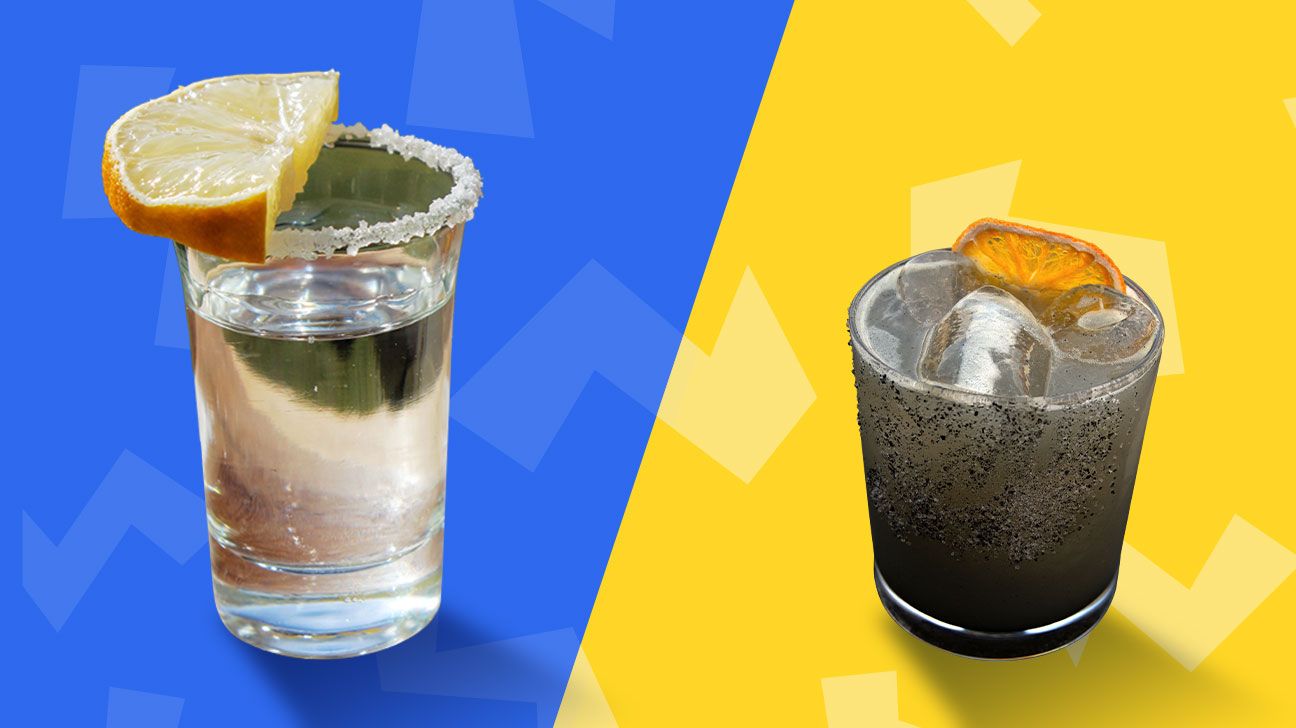Tequila has been a bar mainstay for years (margarita, anyone?). But as imbibers look for different layers of flavor, tequila’s cousin, mezcal (also spelled “mescal”), has also found a place on bar shelves. While both spirits are made from the agave plant, they are distinct in flavor, harvest location, and manufacturing process.
Wondering what the difference is between tequila and mezcal (and whether you’ll have muchos problemas if you accidentally use the wrong one)? Pour a shot, sprinkle on some salt, and keep reading.

Both tequila and mezcal are agave-based alcohols. But if you were to create a Venn diagram of tequila and mezcal, you’d end up with a circle within a circle.
Ignacio “Nacho” Jimenez, of NYC’s Mexican-inspired bar Ghost Donkey, explains: “To make mezcal, you can use around 40 different types of agave. One of them is blue agave, which is the only agave used for the production of 100 percent tequila, so in theory, all mezcal is tequila, but not all tequila is mezcal.”
According to Nico de Soto, co-owner and mixologist at NYC cocktail bar Mace, tequila is harvested from five locations in Mexico: Michoacán, Guanajuato, Nayarit, Tamaulipas, and Jalisco.
Mezcal, however, comes from more locations, including Durango, Guanajuato, Guerrero, San Luis Potosi, Tamaulipas, Zacatecas, Michoacán, Puebla, and Oaxaca. Additionally, he says, the city of Oaxaca produces about 85 percent of the nation’s mezcal. (And now suddenly we want to visit Oaxaca.)
Another major difference between tequila and mezcal, de Soto notes, is in their production processes.
Producing both spirits requires cooking and crushing the hearts of agave plants (also called the piñas, or pineapples), often using a tahona (a human- or animal-powered stone mill made of volcanic rock) to extract the juice. The juice is then fermented and distilled.
“Tequila can only use one type of agave, is steamed inside an industrial oven, and distilled two or three times in copper pots,” he says.
But, adds Jimenez, the process for creating mezcal requires a bit more effort. “Artisanal mezcal is typically distilled in copper stills, clay, or sometimes bamboo pots. None of these forms allow continuous distillation, which means that each portion has to be distilled completely before refilling it,” he says.
This distilling process leads to the main contrast between mezcal and tequila: their tasting notes.
“The one overall characteristic we can use to differentiate the two is the smokiness found in mezcal. This is mainly a result of the cooking process that agave undergoes before becoming mezcal,” says Jimenez.
While agave for tequila is cooked in industrial steam ovens, agave for mezcal is cooked in pits in the ground that burn wood and charcoal, leading to that signature smoky flavor.
The labeling of the alcohols’ ages is different, too, says de Soto, even if the tequila and mezcal are aged similarly. For example, young tequila is called “blanco,” while young mezcal is labeled “joven,” even though they fall into the same aging category of up to 2 months.
Additionally, both are labeled “reposado” when aged from 2 to 12 months. However, after 12 months, things change a bit in terms of aging distinctions.
According to de Soto, añejo mezcal is anything aged for more than 1 year. But for tequila, the term “añejo” refers to alcohol aged from 1 to 3 years.
Despite the many differences between mezcal and tequila, the spirits have some similar traits. These, says de Soto, include the fact that both are Mexican-produced, are aged in oak barrels, and have a strong agave flavor.
While de Soto says that both tequila and mezcal pair well with any type of Mexican food (yes, please), mezcal would be the clear choice for some other dishes.
“Smokier mezcal would pair very well with meat, barbecue, and anything smoky and spicy. Grapefruit, pineapple, corn, chiles, moles, and nuts are all fair game,” he says.
Adds Jimenez, “I just had an amazing Southern barbecue experience paired with some great pechuga mezcal. As for tequila, anything spicy or with a lot of citrus.”
Obviously, both mezcal and tequila can work their magic in drinks, but you can cook with them too! Here are a few edible and drinkable ways we favor.
1. Perfect margarita
You can’t go wrong with a classic margarita on Cinco de Mayo — or any time, really. Serve it on the rocks or with a salt or sugar rim, depending on your vibe. Or try a mezcal margarita with orange liqueur and a wedge of lime.
Get our perfect margarita recipe.
2. Paloma
Let this fruity drink serve as the signature cocktail at your next brunch. Essentially a soda-infused margarita, a paloma is the perfect substitute for anyone who likes their drinks on the sweeter side.
3. Basil mezcal sour
This is a bright and sophisticated way to use mezcal, but it’s still pretty potent, so sip with caution.
Get our basil mezcal sour recipe.
4. Chile-lime-tequila butter
Who knew you could improve upon butter? When it’s time for grilling veggies or steak with Mexican flair, this infused compound butter is a flavoring agent you won’t want to skip. Minced chiles bring heat, while lime juice and a couple of teaspoons of tequila add a hint of tangy acidity.
Get our chile-lime-tequila butter recipe.
5. Mezcal salsa borracha
Whether you want to pour this on everything or serve it alongside a bowl of homemade tortilla chips, this mezcal salsa is all things sweet, spicy, and smoky.
Despite their unique distilling practices, locations, and aging processes, there’s plenty of overlap between the flavors and uses of mezcal and tequila. The primary difference you’ll probably notice between the two is their taste: smokier in mezcal and fruitier in tequila. When using them in cocktails and food pairings, let your taste buds be your guide!
